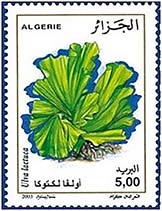| Family: |
Ulvaceae () |
| Max. size: |
100 cm TL (male/unsexed) |
| Environment: |
sessile; marine; depth range 0 - 108 m |
| Distribution: |
Atlantic Ocean, Indo-Pacific: Mexico, from Quebec to Argentina, east to Sweden and to South Africa east to India; in the Bay of Bengal, from Bangladesh south to Australia; from China to New Zealand, east to Alaska and south to Chile. Tropical to polar. |
| Diagnosis: |
Green thallus; expanded into thin, glossy broad sheets with a lobed or undulating margin. Two layers of cells in cross-section; cells polyhedral in surface view and arranged in rather longitudinal rows. Blades up to 30 cm in length (Ref. 80758). |
| Biology: |
Edible. Used as medicine and source of vitamins E, A, and B1 (Ref. 80758). Also has the potential use as animal feeds in the form of ground meal (Ref. 26875). Grows in intertidal areas exposed to air during low tide, in shallow water near shores, or attached to other seaweed species such as Sargassum (Ref. 80758). Often detached and free-floating at midtide (Ref. 801). Abundantly found in areas with varying salinity, and develops rapidly in nutrient-rich waters; thus, common in polluted areas (Ref. 26875). |
| IUCN Red List Status: |
Not Evaluated (N.E.) Ref. 123251)
|
| Threat to humans: |
harmless |
| Country info: |
|
Source and more info: www.sealifebase.org. For personal, classroom, and other internal use only. Not for publication.

